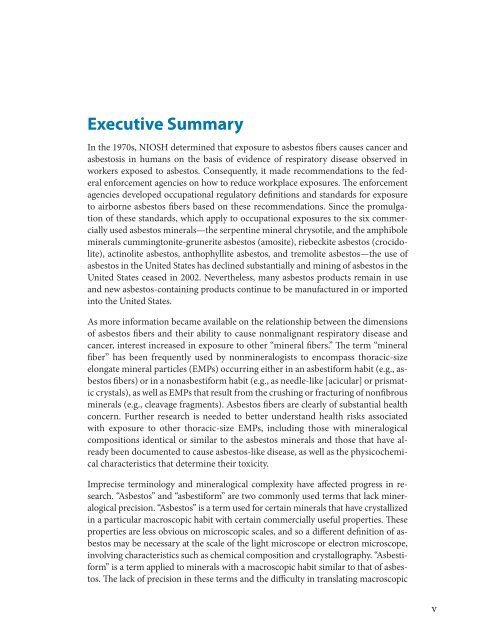Asbestos Fibers and Other Elongate Mineral Particles: State of the ...
Asbestos Fibers and Other Elongate Mineral Particles: State of the ...
Asbestos Fibers and Other Elongate Mineral Particles: State of the ...
- No tags were found...
You also want an ePaper? Increase the reach of your titles
YUMPU automatically turns print PDFs into web optimized ePapers that Google loves.
Executive Summary<br />
In <strong>the</strong> 1970s, NIOSH determined that exposure to asbestos fibers causes cancer <strong>and</strong><br />
asbestosis in humans on <strong>the</strong> basis <strong>of</strong> evidence <strong>of</strong> respiratory disease observed in<br />
workers exposed to asbestos. Consequently, it made recommendations to <strong>the</strong> federal<br />
enforcement agencies on how to reduce workplace exposures. The enforcement<br />
agencies developed occupational regulatory definitions <strong>and</strong> st<strong>and</strong>ards for exposure<br />
to airborne asbestos fibers based on <strong>the</strong>se recommendations. Since <strong>the</strong> promulgation<br />
<strong>of</strong> <strong>the</strong>se st<strong>and</strong>ards, which apply to occupational exposures to <strong>the</strong> six commercially<br />
used asbestos minerals—<strong>the</strong> serpentine mineral chrysotile, <strong>and</strong> <strong>the</strong> amphibole<br />
minerals cummingtonite-grunerite asbestos (amosite), riebeckite asbestos (crocidolite),<br />
actinolite asbestos, anthophyllite asbestos, <strong>and</strong> tremolite asbestos—<strong>the</strong> use <strong>of</strong><br />
asbestos in <strong>the</strong> United <strong>State</strong>s has declined substantially <strong>and</strong> mining <strong>of</strong> asbestos in <strong>the</strong><br />
United <strong>State</strong>s ceased in 2002. Never<strong>the</strong>less, many asbestos products remain in use<br />
<strong>and</strong> new asbestos-containing products continue to be manufactured in or imported<br />
into <strong>the</strong> United <strong>State</strong>s.<br />
As more information became available on <strong>the</strong> relationship between <strong>the</strong> dimensions<br />
<strong>of</strong> asbestos fibers <strong>and</strong> <strong>the</strong>ir ability to cause nonmalignant respiratory disease <strong>and</strong><br />
cancer, interest increased in exposure to o<strong>the</strong>r “mineral fibers.” The term “mineral<br />
fiber” has been frequently used by nonmineralogists to encompass thoracic-size<br />
elongate mineral particles (EMPs) occurring ei<strong>the</strong>r in an asbestiform habit (e.g., asbestos<br />
fibers) or in a nonasbestiform habit (e.g., as needle-like [acicular] or prismatic<br />
crystals), as well as EMPs that result from <strong>the</strong> crushing or fracturing <strong>of</strong> nonfibrous<br />
minerals (e.g., cleavage fragments). <strong>Asbestos</strong> fibers are clearly <strong>of</strong> substantial health<br />
concern. Fur<strong>the</strong>r research is needed to better underst<strong>and</strong> health risks associated<br />
with exposure to o<strong>the</strong>r thoracic-size EMPs, including those with mineralogical<br />
compositions identical or similar to <strong>the</strong> asbestos minerals <strong>and</strong> those that have already<br />
been documented to cause asbestos-like disease, as well as <strong>the</strong> physicochemical<br />
characteristics that determine <strong>the</strong>ir toxicity.<br />
Imprecise terminology <strong>and</strong> mineralogical complexity have affected progress in research.<br />
“<strong>Asbestos</strong>” <strong>and</strong> “asbestiform” are two commonly used terms that lack mineralogical<br />
precision. “<strong>Asbestos</strong>” is a term used for certain minerals that have crystallized<br />
in a particular macroscopic habit with certain commercially useful properties. These<br />
properties are less obvious on microscopic scales, <strong>and</strong> so a different definition <strong>of</strong> asbestos<br />
may be necessary at <strong>the</strong> scale <strong>of</strong> <strong>the</strong> light microscope or electron microscope,<br />
involving characteristics such as chemical composition <strong>and</strong> crystallography. “Asbestiform”<br />
is a term applied to minerals with a macroscopic habit similar to that <strong>of</strong> asbestos.<br />
The lack <strong>of</strong> precision in <strong>the</strong>se terms <strong>and</strong> <strong>the</strong> difficulty in translating macroscopic<br />
v

















